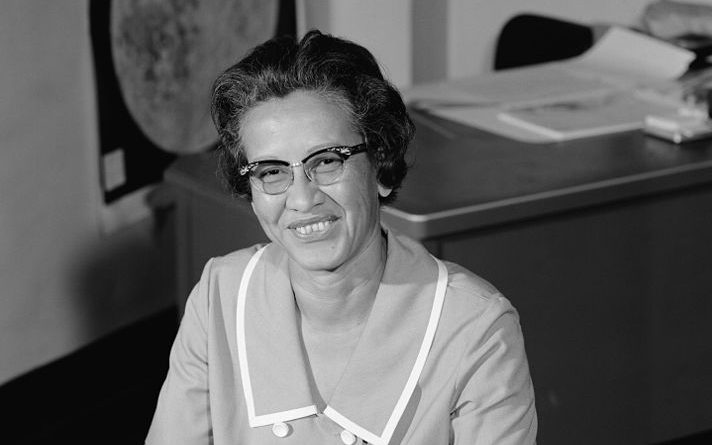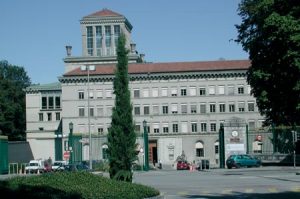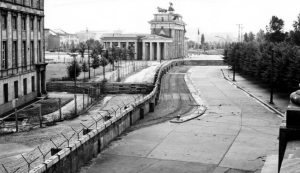Katherine Johnson was approached by one of her friends during a wedding reception in West Virginia in 1953. Her friend mentioned that the Langley Research Laboratories were hiring human computers and that Katherine should check the opportunity out. NACA, or the National Advisory Committee for Aeronautics, was looking for female African-American mathematicians who would be known as “human computers,” who would complete complex mathematical calculations. Katherine loved all of the possibilities that NACA could have in store for her, so she applied, and she moved to Hampton, Virginia with her husband and three children in 1953. Within the year, she had the job at NACA working as a human computer.1
Katherine had always loved math and counting all her life. Anything little Katherine could count, she would, from stairs to the dishes she washed. Katherine was so smart that her first grade teacher sent her up a grade level. As a child, she would always finish her homework first, and then help her siblings with whatever their homework was. She always wanted to understand everything that she could possibly know. Katherine believed that the only dumb questions are the questions that never get asked. She would always raise her hand if she ever had a question. Katherine would never shy away from learning something new.2
Katherine graduated high school at age fourteen and graduated college with the highest honors at the age of eighteen. In college, one of her professors saw her potential and created two different research math courses just for young Katherine. “You would make a good research mathematician,” he told Katherine her sophomore year. “And I am going to prepare you for this career.”3 Math led Katherine to success. All of the help she received as a child and young adult would help her grow and eventually work at NACA and NASA as a female mathematician.
Working at NACA was amazing for Katherine, but working there as an African-American woman came with its own set of challenges to overcome. She and her male coworkers working on similar projects not only had a completely different set of equipment, but they each worked in separate buildings. Katherine was also discriminated against because of her skin color. NACA had segregated bathrooms and a segregated lunchroom. She broke the norms of the time by using whichever restroom was closest to her desk, and by eating at her desk to avoid the lunchroom all together.4 Segregation was still very much alive in Virginia in the 1950s, when she first joined NACA, but this didn’t stop her from achieving amazing things.
Women at the time were not allowed to take part in any of the high level meetings or briefings of the Flight Research Division. Curiously, Katherine didn’t let that stop her: “I’d ask what had gone on in the briefing—I’d listen and listen, and ask questions. Then, of course, I’d ask why I couldn’t go myself, and eventually they just got tired of answering all my questions and just let me in.”5 She did what was unheard of at the time, by being a woman who got into the engineers’ meetings and briefings. Katherine would continue to expand her curious mind and make herself known and respected.
In 1957, four years after she joined NACA, the Space Race between the United States and the Soviet Union started heating up after Sputnik was launched by the Soviets. Katherine was in the perfect spot to expand her knowledge and make herself the best she could be. The National Advisory Committee for Aeronautics soon changed its name to the National Aeronautics and Space Administration or more commonly known as NASA. NASA wanted to do something no one had done before, namely send someone into space. They created Project Mercury. The main mission that Katherine worked on was Mercury-Redstone 3 or Freedom 7.6

Freedom 7 was already decided by NASA: the flight would be short and, would go into space without orbiting the Earth. The flight path would be a parabola that would need to be precise. The space craft needed to land in a specific spot in the Atlantic Ocean where Navy ships would be waiting to retrieve the space craft and the astronaut inside. Katherine was tasked with charting the mission’s trajectory because she had proven herself to be a reliable mathematician and a capable researcher. “Let me do it,” she told the NASA engineers. “Tell me when you want it and where you want it to land, and I’ll do it backwards and tell you where to take off.”7
Katherine figured out what the rocket’s altitude and speed should be in order to reach space and subsequently the splashdown location, all by using analytical geometry.8 On the day of the launch, questions filled the air with everyone wondering if her calculations were correct. Did she do her math right? What would happen if her math was wrong? Would they land in the spot they planned on landing? If this flight didn’t work out correctly, would the United States be out of the space race with the Soviets?
The Freedom 7 rocket obtained a top speed of 5,180 miles an hour and a peak altitude of 116 miles.9 She had done it. Katherine successfully helped send astronaut Alan Shepard into space and brought him safely back to earth. This major success was a big stepping stone for not only Katherine, but for every woman working at NASA. Katherine became a respected mathematician within NASA, not only by other mathematicians, but by everyone involved in her division, the Flight Research Division.10

Katherine became so well known and respected that she was asked to check the new super-computers that were prone to blackouts and hiccups. “But before astronaut John Glenn would launch aboard Mercury’s powerful Atlas rocket, he had a demand for NASA’s leadership: Katherine Johnson needed to review the computations. “If she says they’re good, then I’m ready to go,” he told them.”11 Her brain was capable of completing the same tasks as the computers, but with less error. At times, she was more accurate than the computers.
With all of her knowledge that she contributed to NASA, she was able to write and co-write twenty six NASA research reports in the thirty-three years she had worked there, until 1986.12 She explained, “We wrote our own textbook, because there was no other text about space. We just started from what we knew. We had to go back to geometry and figure all of this stuff out.”13 Katherine helped create a good portion of what NASA and the world knows about space. She was an innovator.
“In 2015, President Barack Obama personally awarded Katherine the Presidential Medal of Freedom. At the ceremony, he stated, ‘In her thirty-three years at NASA, Katherine was a pioneer who broke the barriers of race and gender, showing generations of young people that everyone can excel at math and science, and reach for the stars.’ Indeed, with her perseverance, intelligence, and hard work, Katherine overcame many obstacles and helped take her country—and the whole of humanity—all the way to the moon.”14

Katherine Johnson did so many amazing things during her life time. She sent people to space and brought them safely back. The only way she accomplished so many spectacular things was that she asked questions. She led the way for women in not only NACA and NASA, but in STEM, to explore and create amazing discoveries about the world we live in.
- Joseph Taylor, “The Path to the Moon: The Story of Katherine Johnson,” Cricket, (2019), 19. ↵
- Joseph Taylor, “The Path to the Moon: The Story of Katherine Johnson,” Cricket, (2019), 19. ↵
- Joseph Taylor, “The Path to the Moon: The Story of Katherine Johnson,” Cricket, (2019), 19. ↵
- Joseph Taylor, “The Path to the Moon: The Story of Katherine Johnson,” Cricket, (2019), 19. ↵
- Contemporary Black Biography, Vol. 61, 2007, s.v. “Johnson, Katherine Coleman Globe,” by Margaret Alic. ↵
- Contemporary Black Biography, Vol. 61, 2007, s.v. “Johnson, Katherine Coleman Globe,” by Margaret Alic. ↵
- Contemporary Black Biography, Vol. 61, 2007, s.v. “Johnson, Katherine Coleman Globe,” by Margaret Alic. ↵
- Joseph Taylor, “The Path to the Moon: The Story of Katherine Johnson,” Cricket, (2019), 19. ↵
- Joseph Taylor, “The Path to the Moon: The Story of Katherine Johnson,” Cricket, (2019), 19. ↵
- Margot Lee Shetterly, Winifred Conkling, and Laura Freeman, Hidden Figures: The Ture Story of Four Black Women and the Space Race (Harper, Harper Collins Publishers, 2018), 34. ↵
- Joseph Taylor, “The Path to the Moon: The Story of Katherine Johnson,” Cricket, (2019), 19. ↵
- Margot Lee Shetterly, Winifred Conkling, and Laura Freeman, Hidden Figures: The True Story of Four Black Women and the Space Race (Harper, Harper Collins Publishers, 2018), 23. ↵
- Michael Mink, “Katherine Johnson Did The Math For NASA When It Counted Most,” Investors Business Daily, December 29, 2016. ↵
- Joseph Taylor, “The Path to the Moon: The Story of Katherine Johnson,” Cricket, (2019), 19. ↵




30 comments
Marie Peterson
This was a great article. Katherine Johnson is not only an inspiration but a pioneer for women in STEM. I loved reading more about someone who has made such a major impact in a field that I intend to work in. Her determination and dedication to her work and furthering not only space travel but fighting discrimination is incredible. Great job!
Kanum Parker
This article was a prim example of if you find enjoyment out of something you can make a living out of it. Not only that but she also showed many people no matter what obstacle there is you can get around it. She never gave up even she was at a disadvantage. She lead the way for other women in the companies and changed the future for women. All she had to do was ask questions. Don’t be shy and speak out you never know what that will lead you to later on in life.
Aracely Beltran
Amazing article! This woman is one of my inspirations. I love reading her stories over and over, I first heard of her from the book “hidden figures”. Then I watched the movie and it is crazy about the amazing work she did. I loved it when she proved everyone wrong! She is a great role model for women but especially us minorities.
Ana Cravioto Herrero
Great article! I was interested in this article because I saw the movie Hidden Figures and since the, I had admired her so much. Katherine Johnson is such an intelligent woman and it is crazy to think about how successful she still was do to her persistence and dedication. I am glad that she fought against discrimination and truly made an impact on the world in many different ways.
Kennedy Arcos
This was such an inspirational article about such an inspirational woman. I think it’s so interesting to learn about such intelligent people like herself. It’s crazy to me that she was able to graduate both high school and college at such a young age! One of the most inspiring things about her was how she continued to work for NASA despite the discrimination. I loved this article!
Mia Hernandez
Katherine Johnson was a truly inspiration women for both those of color and those in the STEM fields. Katherine didn’t just have to overcome the hardships of being a woman in a male dominated field, but she also had to deal with issues of segregation and racial prejudices. She proved to not only others but herself, that she was just as smart as a man and was capable of performing the tasks necessary to get a man into space.
Arsema Abera
It’s always fascinating to read about intelligent people and I also believe there is a movie about Katherine called hidden figures which portray Katherine’s struggle and so on. she was a genius what really surprised me was she graduated from high school when she was 14 while most of us are still in middle school. Although segregation had been a huge issue at that time, she overcame the problem and participated in one of the nation’s greatest achievements of launching the first satellite.
Sofia Almanzan
She is an inspiring woman. Women are never seen as mathematicians or successful mathematicians at that. I saw the movie that was made on her inspiring journey to how she became the woman behind getting to the moon. She was an
anomaly being not only a woman but an african american woman. Sadly I heard recently she passed away but she was definitely a woman who changed history.
Kendall Guajardo
I have watched the movie that was made about her and let me tell you this woman was so much more than an inspiration, she jostled the world with her intelligence and confidence of her own capabilities. To be so forthcoming about being talented as a woman could have not been her personality but she did everything on her own and for herself. It was awesome to hear that her professor saw that potential in her and mentored her to the best she could be. We need more people to not only be recognized in the face of “obstacles,” which at the time was her gender and race, but to above all make space for themselves to be heard. Her reputation was made by herself because she did something she loved and never apologized for it.
Lesley Martinez
I can’t believe there are actual “human computers” in this world. Katherine Johnson is surely an individual I aspire to be like. To graduate high school and college aT such a young age is mind-blowing. I like that she believed that “the only dumb questions are the questions that never get asked,” which ultimately shows how successful she was by doing this. Her boldness to continue working for the NASA, even after being discriminated demonstrates the love she had for her job. This is a wonderful and inspiring article!